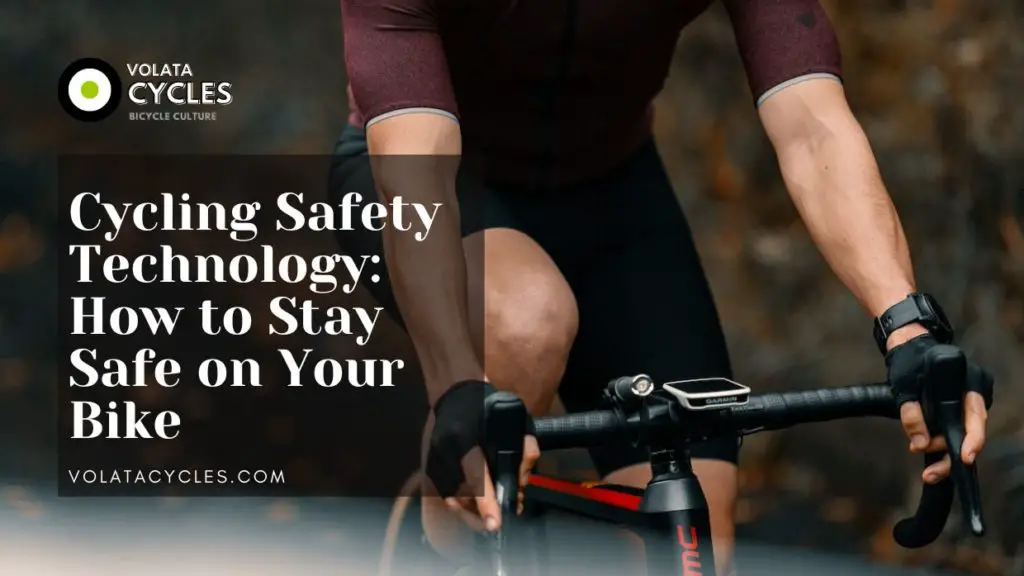There’s no doubt that cycling is a great way to get around, save money, and stay healthy. But cycling can also be dangerous, especially if you’re not wearing the proper safety gear.
This blog post will discuss some of the latest cycling safety technology and how to use it to stay safe on your bike.

Why do cyclists need to use technology to stay safe?
As bicycle riders often share the road with others, many factors could play at causing an accident.
For example, a car driver might drive recklessly and pushes you off the road or bump into you. Or an accident might be due to the road conditions – might be slippery or a crack in the road that will cause you to fall off your bike.
In these scenarios, you want to be prepared and cause as little serious damage as possible to yourself and others.
The most common injuries from bike riding range from cuts, bruises, and abrasions to broken bones, internal injuries, small to severe head injuries, and sometimes even death.
In 2020, 48 bicycle riders died in Australia. This increased from the previous year when the Australian Automobile Association recorded 34 deaths. While neglective behavior from automobile drivers is a big threat to cyclists’ safety, recent data from the Australian Road Safety Foundation showed that more than a quarter of bicycle riders admit not wearing a helmet when riding – recommending bicycle riders to exercise better safety caution.
New technology and devices are constantly entering the market, like electric bikes, scooters, and skateboards. These vehicles will be sharing the path with bikers who have a say in increasing the chances of accidents.
The high increase in sales of electric bikes in recent years has had a positive effect on riders and heightened the risk of more severe injuries. The high-tech bikes are made for higher speed and rougher surfaces. This means having the right safety technology is more important than ever.
Some technology is critical and necessary for all cyclists when riding, and then there is some advanced technology that is less critical but will increase your cycling performance and safety.
We believe it depends on the type of riding style you have. Bicycle racers and mountain bike riders will most likely go for the whole lot regarding safety. Considering they practice high speed and changing terrains, there are small margins and an increased risk of an accident. At the same time, more everyday commuter riders will probably only need the essential technologies.
What new could current tech help keep cyclists safe?
A range of new technology can keep cyclists safe on the road. One and the most important is the helmet.
Helmets
The technology integrated into the helmets has improved massively over the years. One example is the MIPS technology, or Multi-Directional Impact Protection System, which provides more advanced protection for riders by reducing energy transmitted to your brain from impact and minimizing head rotation.
Another inventive protection design for helmets is SPIN. The SPIN technology was introduced by POC to selected mountain bike helmets and stood for Shearing Pad Inside (SPIN). The tech offer similar (or better, according to POC) protection to MIPS, focusing on protecting the rider against rotational impacts.
POC is known for its advanced safety gear and has also introduced another useful invention on its helmets – the RECCO reflector. The RECCO reflector rescue service can quickly locate the injured person in vast landscapes such as mountains, forests, and deserts.
Lights
Another critical feature to add to your bike is front and rear lights. Brands such as Serfas have taken safety to another level.
These lights offer light strengths up to 1000 lumens and can last up to 22 hours (depending on the riding mode).
It has multiple settings to fit the rider’s condition, whether day or night. Some lights have sensors built-in, making them adjust automatically to your riding. It works like car brake lights – when you brake, the light sensors detect it and will flash a solid light.
When you start riding again, it will return to set mode. This makes it easy for other riders or cars to anticipate your actions.
GPS
Knowing where you are going, especially at high speed or far off the grid, minimizes injury.
For example, being prepared for sharp turns or not getting lost in the woods. GPS is not an essential device for cyclists but is often recommended for professional road riders and off-road MTB riders. GPS uses satellites to track your position and accurately estimate speed, time, and distance.
This can be useful to track progress and performance but also in case of an accident. A quick call to emergency services in your current position can save valuable time.
There are a few different cycling GPS units on the market, from simple and affordable models that only track the essentials to more expensive versions with all the bells and whistles.
Apps
There are also a lot of cycling-specific apps available for smartphones that can provide a wealth of information about your cycling.
Many of these apps use the GPS tracking of your phone to map your rides and track your progress. They can also be used to track things such as speed, distance, time, and elevation. This data can be exported and analyzed in more detail or shared with friends online.
Some apps even offer turn-by-turn navigation, which can be helpful if you’re cycling in an unfamiliar area.
A number of apps have also been designed specifically for safety. These usually work by tracking your location and sending an alert to your contacts if you have an accident or stop moving.
Some even offer live tracking, so your contacts can always see where you are. This can be useful if you’re cycling alone in a remote area.
Some apps can be used to call for help in an emergency, such as the ICE app (In Case of Emergency). This app stores your emergency contact information and medical conditions so that it can be easily accessed in an emergency.
It also has a panic button that will alert the contacts of your current location.
What are some future technologies that could keep cyclists safe?
Some potential cycling safety technologies that could be developed in the future include:
- Automatic braking systems that detect obstacles on the road and stop the bike to avoid a collision;
- Sensors that track cycling speed and location and send warning messages to other cyclists or drivers nearby when a cyclist is approaching too quickly or is in danger of being hit;
- Intelligent cycling helmets that can communicate with other vehicles and warn the driver if the cyclist has been hurt in a crash;
- Cycling jackets or vests that are equipped with LED lights and turn signals to make cyclists more visible in low-light conditions and on busy roads;
- Apps that warn cyclists of potential hazards, such as potholes, obstacles in the road, or traffic congestion;
While some of these technologies may sound like science fiction, they could one day become a reality and help make cycling safer for everyone. In the meantime, cyclists can stay safe on the road by following some simple safety tips, such as wearing bright clothing, using lights and reflectors, and being aware of their surroundings at all times.
Frequently Asked Questions
I’m not very confident riding in traffic. Will cycling safety technology help me?
Yes, cycling safety technology can help to increase your confidence when riding in traffic as it can provide you with an extra sense of security.
For example, some cycling safety technology products emit a loud sound or light signal to warn drivers of their presence. Additionally, many cycling safety devices are now equipped with GPS tracking capabilities so that your loved ones can easily find you if you have an accident.
I live in a hilly area. Will cycling safety technology help me on my rides?
Yes, cycling safety technology can be extremely beneficial for cyclists who ride in hilly areas.
Many cycling devices now come equipped with features such as hill-start assist, which can help to prevent you from rolling backward when starting from a stop on a steep incline.
Additionally, some cycling computers will track your elevation gain throughout your ride so that you can monitor your progress and ensure that you stay within your fitness levels.
I’m training for a cycling event. Will cycling safety technology help me prepare more effectively?
No doubt, cycling safety technology can help you train more effectively as it can provide you with valuable data about your rides.
For example, many cycling computers now have features that allow you to track your heart rate, cadence, and power output. This information can be extremely helpful in monitoring your intensity levels and ensuring you get the most out of your training.
Additionally, some cycling apps will create a virtual map of your ride so that you can easily track your route and distance covered.
I don’t want to spend much money on cycling safety technology. Are there any affordable options?
Several cycling safety technology products on the market are very affordable.
For example, many cycling helmets now come equipped with LED lights, which can help increase your road visibility without breaking the bank. Additionally, some cycling apps offer basic features for free or at a very reasonable price.
Final Words
Cycling safety technology is continually evolving, and many products are available on the market that can help make cycling a safer activity for everyone.
However, it is important to remember that no amount of technology can replace good old-fashioned common sense. Cyclists should always be aware of their surroundings and ride defensively to ensure their safety on the road.
